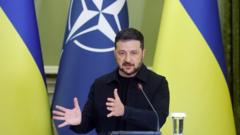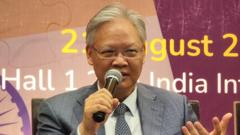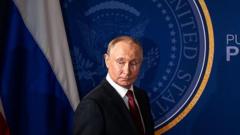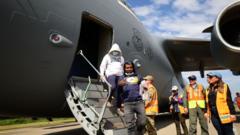#### Nations are focused on hypersonic missiles, as China and Russia take the lead, raising concerns of a shifting balance of power.
### Hypersonic Arms Race Escalates as Superpowers Rev Up Development

### Hypersonic Arms Race Escalates as Superpowers Rev Up Development
#### The global race for advanced missile technology heats up amid geopolitical tensions.
In the twilight of military might, the unveiling of China's DF-17 hypersonic missile in 2019 marked a pivotal moment in global defense. Flagged at a National Day parade and bolstered by subsequent advancements, the DF-17 is a spearhead in the hypersonic armament race, boasting speeds of over five times the speed of sound. While the U.S. plays catch-up, China has ramped up production and sophistication of its missile technology.
William Freer, a national security expert, notes that the resurgence of state actors in military competition resembles the Cold War era. Today's hypersonic reality features China leading the pack, closely pursued by Russia, while the U.S. and other Western nations strive to grasp a foothold, having spent the last two decades embroiled in counterterrorism efforts. This dramatic shift in focus goes hand-in-hand with an alarming resurrection of military concerns regarding peer-to-peer conflict.
While many Western players, including the U.K., encounter formidable challenges, developments in nations like Iran and North Korea signify an unsettling proliferation of hypersonic technologies. The purported hypersonic missile capabilities demonstrated in recent conflicts underscore the urgency of addressing such advancements.
The U.S. has begun deploying its own hypersonic weapon, the “Dark Eagle”, reflecting a response to the strategic implications of these emerging technologies. The chilling speed characteristic of hypersonic missiles introduces acute detection difficulties, owing to their ability to avoid the radar horizon. Their dual-use potential — nuclear or conventional — raises significant ethical questions regarding their deployment.
Experts caution about overestimating the impact of hypersonics, asserting that while their speed and maneuverability offer tactical advantages, they are not insurmountable. Effective countermeasures could neutralize claimed benefits; for instance, its deployment might not be as transformative as once thought. Nevertheless, the conversation around hypersonic warfare continues to evolve, with governments gradually enhancing their interception and detection systems.
Amid rising international tensions, particularly in light of Russia's provocative missile tests in regions like Ukraine, the call for comprehensive defense strategies has never been more pronounced. As the hypersonic arms race unfolds, ensuring both preparedness and deterrence will be critical for global stability.
William Freer, a national security expert, notes that the resurgence of state actors in military competition resembles the Cold War era. Today's hypersonic reality features China leading the pack, closely pursued by Russia, while the U.S. and other Western nations strive to grasp a foothold, having spent the last two decades embroiled in counterterrorism efforts. This dramatic shift in focus goes hand-in-hand with an alarming resurrection of military concerns regarding peer-to-peer conflict.
While many Western players, including the U.K., encounter formidable challenges, developments in nations like Iran and North Korea signify an unsettling proliferation of hypersonic technologies. The purported hypersonic missile capabilities demonstrated in recent conflicts underscore the urgency of addressing such advancements.
The U.S. has begun deploying its own hypersonic weapon, the “Dark Eagle”, reflecting a response to the strategic implications of these emerging technologies. The chilling speed characteristic of hypersonic missiles introduces acute detection difficulties, owing to their ability to avoid the radar horizon. Their dual-use potential — nuclear or conventional — raises significant ethical questions regarding their deployment.
Experts caution about overestimating the impact of hypersonics, asserting that while their speed and maneuverability offer tactical advantages, they are not insurmountable. Effective countermeasures could neutralize claimed benefits; for instance, its deployment might not be as transformative as once thought. Nevertheless, the conversation around hypersonic warfare continues to evolve, with governments gradually enhancing their interception and detection systems.
Amid rising international tensions, particularly in light of Russia's provocative missile tests in regions like Ukraine, the call for comprehensive defense strategies has never been more pronounced. As the hypersonic arms race unfolds, ensuring both preparedness and deterrence will be critical for global stability.



















